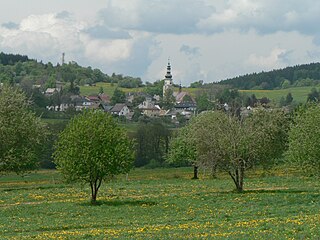This article needs additional citations for verification .(December 2009) |
| |||
|---|---|---|---|
| Buildings and structures +... |
The year 1727 in architecture involved some significant events.
This article needs additional citations for verification .(December 2009) |
| |||
|---|---|---|---|
| Buildings and structures +... |
The year 1727 in architecture involved some significant events.

Jan Blažej Santini Aichel was a Czech architect of Italian descent, whose major works represent the unique Baroque Gothic style - the special combination of the Baroque and Gothic styles.

Mathematics and architecture are related, since, as with other arts, architects use mathematics for several reasons. Apart from the mathematics needed when engineering buildings, architects use geometry: to define the spatial form of a building; from the Pythagoreans of the sixth century BC onwards, to create forms considered harmonious, and thus to lay out buildings and their surroundings according to mathematical, aesthetic and sometimes religious principles; to decorate buildings with mathematical objects such as tessellations; and to meet environmental goals, such as to minimise wind speeds around the bases of tall buildings.

Cosmas Damian Asam was a German painter and architect during the late Baroque period. Born in Benediktbeuern, he lived in Rome from 1711 to 1713 to study at the Accademia di San Luca with Carlo Maratta. In 1713, Asam won the Academy's first prize for his drawing of Miracle of Saint Pio. In Germany, he worked with his brother Egid Quirin, a sculptor and stucco worker, on building and decorating entirely new churches or redesigning churches in the Baroque style. Their joint projects are often attributed to the "Asam Brothers". Cosmas Damian died in Munich.

Baroque architecture is a highly decorative and theatrical style which appeared in Italy in the early 17th century and gradually spread across Europe. It was originally introduced by the Catholic Church, particularly by the Jesuits, as a means to combat the Reformation and the Protestant church with a new architecture that inspired surprise and awe. It reached its peak in the High Baroque (1625–1675), when it was used in churches and palaces in Italy, Spain, Portugal, France, Bavaria and Austria. In the Late Baroque period (1675–1750), it reached as far as Russia, the Ottoman Empire and the Spanish and Portuguese colonies in Latin America. In about 1730, an even more elaborately decorative variant called Rococo appeared and flourished in Central Europe.

The Metropolitan Cathedral of Saints Vitus, Wenceslaus and Adalbert is a Catholic metropolitan cathedral in Prague, and the seat of the Archbishop of Prague. Until 1997, the cathedral was dedicated only to Saint Vitus, and is still commonly named only as St. Vitus Cathedral.

The year 1754 in architecture involved some significant events.

Nepomuk is a town in Plzeň-South District in the Plzeň Region of the Czech Republic. It has about 3,500 inhabitants. It is known as the birthplace of Saint John of Nepomuk, who was born here around 1340 and whose statue can be seen on the town square.

Žďár nad Sázavou District is a district in the Vysočina Region of the Czech Republic. Its capital is the town of Žďár nad Sázavou.

Žďár nad Sázavou is a town in the Vysočina Region of the Czech Republic. It has about 21,000 inhabitants. The town is an industrial and tourist centre. It is known for the Pilgrimage Church of Saint John of Nepomuk, which is a UNESCO World Heritage Site.

Kilian Ignaz Dientzenhofer was a German Bohemian architect of the Baroque era. He is among the most prolific and renowned architects of his era in Bohemia. He was born into the well known Dientzenhofer family of architects and is considered its most talented and productive member.
Carlo Lurago was an Italian architect who was active in Prague.

The Pilgrimage Church of Saint John of Nepomuk at Zelená hora is a religious building at the edge of Žďár nad Sázavou, Czech Republic, near the historical border between Moravia and Bohemia. It is the final work of Jan Santini Aichel, a Bohemian architect who combined the Borrominiesque Baroque with references to Gothic elements in both construction and decoration.

Andělská Hora is a town in Bruntál District in the Moravian-Silesian Region of the Czech Republic. It has about 400 inhabitants.

The Church of the Assumption of Our Lady and Saint John the Baptist is a Gothic and Baroque Gothic church north-east of Kutná Hora in the Czech Republic and is listed in the UNESCO World Heritage List together with the Church of St. Barbara and other monuments in Kutná Hora. It is one of the most important Czech Gothic buildings built in the time of the last Přemyslids and also a very important and one of the oldest examples of the Baroque Gothic style.

Klášter is a municipality and village in Plzeň-South District in the Plzeň Region of the Czech Republic. It has about 200 inhabitants. The village was founded inside the ruins of a monastery, which was destroyed in the 15th century.

Zelená Hora is a castle in Klášter in the Plzeň Region of the Czech Republic. It is located on an eponymous mountains, close to the town of Nepomuk.
Johann Nepomuk Fuchs was a Lower Styrian church architect and, alongside Josef Hueber (1715/17–1787), was the main representative of the "Styrian Baroque" in the third quarter of the 18th century.

Czech Baroque architecture refers to the architectural period of the 17th and 18th century in Bohemia, Moravia and Silesia, which comprised the Crown of Bohemia and today constitute the Czech Republic.
Zelená Hora may refer to places in the Czech Republic: